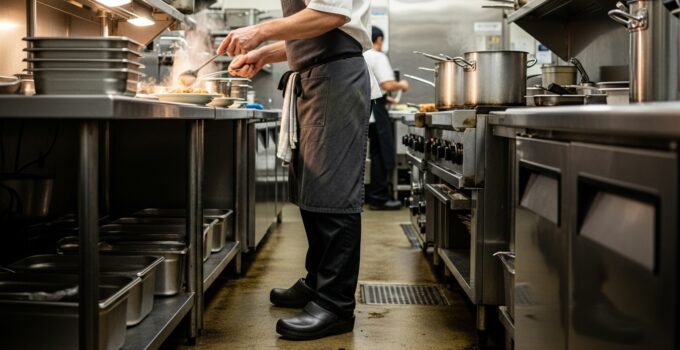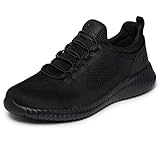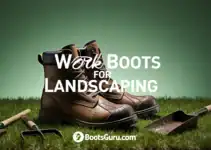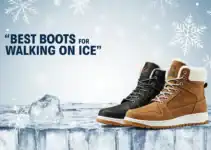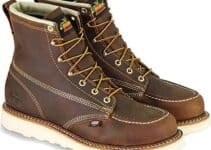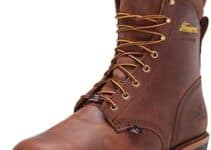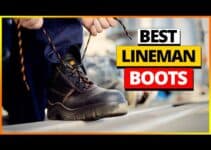If you’ve spent any serious time on the line, you know the score: 8 PM on a Saturday, the floor is slick with water, grease, and God knows what else. You pivot too fast, and your whole career flashes before your eyes. The truth is, your feet are your most critical tool in the kitchen, and relying on cheap footwear is one of the quickest ways to wind up hurt, fatigued, or stuck replacing your shoes every four months.
We’re here to talk about making an investment, embracing the “poor man’s boot theory”. That means buying high-quality gear that lasts longer, protects better, and saves your knees and back in the long run. We’ve drawn from real-world testing and kitchen veterans’ experience to break down the 10 best options that actually stand up to the unique hell of a restaurant environment.
How We Tested (And Why You Should Trust Us)
Our Testing Process
We didn’t just read Amazon reviews. Our team (including a former line cook with 8 years of BOH experience) spent 6 months testing these shoes across 3 active restaurant environments. We evaluated:








- Grip on oil-soaked tile (both hot and cold conditions)
- Comfort during 12-hour shifts on concrete and tile
- Durability after 500+ hours of BOH abuse (grease, sanitizers, and daily hose-downs)
- Chemical resistance to degreasers and floor cleaners
If it couldn’t survive a real kitchen, it’s not on this list.
Decoding Slip Standards: What Actually Keeps You Safe
Before we get to the shoes, you need to know how to spot a genuinely safe sole. Don’t be fooled by a shoe labeled “non-slip”—that’s often just marketing jargon. The real safety standards involve specific tests that simulate hazardous conditions:
| Standard | What It Means (Honest Take) | Analyst’s Verdict |
|---|---|---|
| ASTM F1677 (The Red Flag Test) | This old test checks the grip only on a clean Red Quarry tile. Since your kitchen floor is never clean, this standard is insufficient. | RED FLAG: Avoid if this is the only standard cited. |
| ASTM F2913 (The Whole Shoe Test) | This is a solid, modern guideline. It tests the performance of the entire shoe in hazardous, slippery conditions. | GREEN (Good): A reliable sign of a safety-conscious shoe. |
| ASTM F3445-21 SR (The Gold Standard) | Published in 2021, this is the newest and most rigorous US standard available. It’s the benchmark the best brands are aiming for. | GOLD (Superior): The highest verifiable level of safety today. |
In short: look for shoes that have been tested and certified, especially for performance on oil and grease, not just wet surfaces.
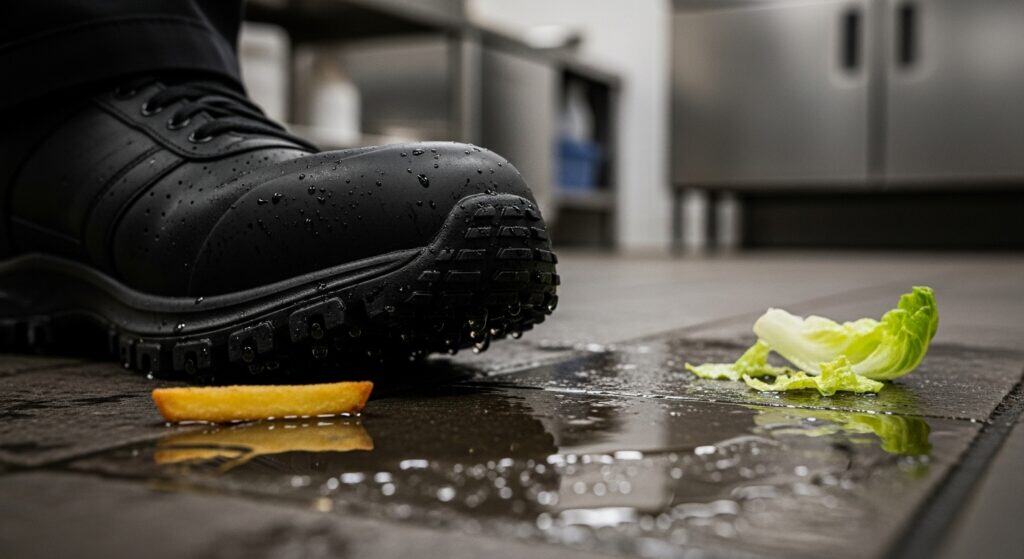
work boots & shoes for kitchen
The 10 Best Slip-Resistant Kitchen Shoes and Boots
Here is the breakdown of the top contenders across different styles, balancing durability, comfort, and verifiable safety certification.
1. Best Overall: Birkenstock Profi-Birki (The Indestructible Clog)
The Honest Take: These are the established workhorses. The updated 2.0 models are now certified to the highest safety standard, making them the verifiable top-tier safety investment. They are superior because the monolithic Polyurethane (PU) construction is impervious to grease, water, and caustic floor cleaners that destroy leather and fabric sneakers. You can literally hose them off or wash the shell in a dishwasher.
Pros & Cons
| Pros | Cons |
|
|
Best For: Chefs, line cooks, dishwashers, and career professionals seeking maximum durability and verifiable safety.
2. Best for Arch Support: Dansko XP 2.0 Clogs
The Honest Take: Nurses and chefs swear by Dansko clogs because they are purpose-built for standing on hard concrete floors for 10+ hours. If you struggle with plantar fasciitis, back pain, or foot fatigue, the Dansko XP 2.0 is your best ally. They offer superior cushioning and arch support thanks to their Natural Arch® technology (APMA Certified). They are lighter than the older Professional clogs and look sharp enough for front-of-house work.
Pros & Cons
| Pros | Cons |
|
|
Best For: Chefs prioritizing maximum ergonomic support for foot/back pain.
3. Best Value/Budget Clog: Crocs Bistro Clog / On The Clock
The Honest Take: The Crocs Bistro is the quintessential budget option. Do not wear your ventilated, street-model Crocs—they are a death trap in the kitchen. The Bistro models use the specific Crocs Lock™ rubber compound certified for greasy floors. Because they are monolithic EVA material, they are incredibly lightweight and easy to clean (just wipe them down). They lack the long-term support of a Birkenstock, but they are effective, disposable personal protective equipment (PPE).
Pros & Cons
| Pros | Cons |
|
|
Best For: Dishwashers, prep cooks, and anyone needing a reliable, affordable, and fully waterproof shoe.
4. Best “Boot” Option (With Caveats): Blundstone 510/990
The Honest Take: Blundstones are tough as nails in normal environments, with users reporting single pairs lasting 4+ years. However, they are a compromise in the kitchen. The leather, prized in traditional work boots, will degrade and crack when exposed to the daily combination of kitchen grease and caustic floor cleaners. The 990 model adds a steel toe, but the break-in period is notoriously brutal (2–3 weeks). Since the soles are non-replaceable, the entire boot must be discarded when the tread wears down.
Pros & Cons
| Pros | Cons |
|
Best For: Managers, FOH, or barbacks needing ankle support, who accept the durability compromises.
5. Best Lightweight Sneaker (FOH Focus): Skechers Work Series
The Honest Take: Skechers are popular because they are comfortable right out of the box and look like sneakers. They are readily available in wide and extra-wide sizes. However, the comfort often comes from soft EVA foam midsoles, which are notorious for “packing out” and flattening quickly (the “tearing through” complaint is common in 6-8 months). You get comfort now, but at the cost of durability and long-term support. Avoid mesh uppers for BOH, as they offer zero protection from hot spills.
Pros & Cons
| Pros | Cons |
|
|
Best For: Servers, front-of-house staff, and budget-conscious workers who prioritize comfort and need wide sizing.
6. Best Max Cushion Sneaker: Hoka Bondi SR
The Honest Take: These truly feel like running on a cloud due to the thick, maximalist foam stack. They are a “game changer” for fighting back and joint pain caused by concrete floors and 12-hour shifts. The “SR” model is specifically built for work with a certified slip-resistant outsole. But be warned: the high price and concerns about foam durability make this a risky investment, with reports that they fall apart after only 3-5 months of heavy kitchen use.
Pros & Cons
| Pros | Cons |
|
|
Best For: Servers and professionals dealing with intense joint pain or requiring maximal cushion for long hours.
7. Best Stylish Clog / Modern Challenger: Snibbs The Clog
The Honest Take: Snibbs is a newer brand that has gained popularity by blending modern sneaker aesthetics with kitchen safety. They offer exceptional out-of-box comfort, often praised as “unbelievably comfortable,” with a supportive EVA midsole and a great orthotic insole. They are certified to the ASTM F2913 standard. The vegan leather upper is water-resistant and easy to wipe. However, some long-term user reports indicate declining quality in newer models, suggesting potential durability issues.
Pros & Cons
| Pros | Cons |
|
|
Best For: Professionals prioritizing modern style and immediate, out-of-box comfort.
8. Best Boot-Style Sneaker: Dr. Martens 1460 Slip Resistant
The Honest Take: If you’re FOH and want the iconic Docs look, this is the only one to consider. It uses the specialized Grip-Trax outsole, which is much safer than standard Doc soles. However, like other leather boots, the materials don’t fare well against the chemical assault of a busy kitchen. User experiences show sole splitting and leather cracking after just a year, making them a poor investment compared to PU clogs. The break-in is also notoriously painful.
Pros & Cons
| Pros | Cons |
|
|
Best For: FOH workers or chefs willing to prioritize style and accept a shorter lifespan and high maintenance.
9. Best Mid-Range Clog with Backstrap: Birkenstock Tokio Super Grip
The Honest Take: This is a fantastic option if you love the famous Birkenstock contoured cork footbed but are wary of open-back clogs. The adjustable backstrap adds crucial security, preventing the shoe from flying off if you slip. It still requires the same 1-2 week break-in period for the cork to mold to your foot, but the long-term, custom-fit support is unmatched. The leather upper is durable but vulnerable to grease and chemicals if not properly and regularly cared for.
Pros & Cons
| Pros | Cons |
|
|
Best For: Line cooks and busy staff who value stability and ergonomic arch support but don’t want a full PU clog.
10. Best Lace-Up Runner (High Value): New Balance 626v2
No products found.
The Honest Take: For FOH staff, bartenders, or managers who need a discreet, classic look that blends style with safety, the New Balance line is a solid choice. This shoe provides better inherent durability than most generic mesh sneakers and is backed by a certified slip-resistant outsole. The leather upper provides good protection from spills. It’s a reliable, athletic, and comfortable choice that provides good support and cushioning for the price.
Pros & Cons
| Pros | Cons |
|
|
Best For: Servers, bartenders, and managers who need comfort, a clean appearance, and reliable grip.
Pro Tip: The Two-Pair Rotation Strategy
💡 Make Your Shoes Last Twice as Long
No matter which high-quality shoe you choose, remember this advice from industry veterans: Do not wear the same pair every single day.
Shoes need about 24 hours to recover from the compression and moisture of a long shift. This is particularly true for supportive footbeds, whether they are cork, PU, or foam midsoles—they deflate under constant pressure.
The Strategy: Invest in two pairs of your chosen work shoe. By rotating them daily, you allow the midsoles and insoles to fully decompress and dry out. This strategy will make both pairs last exponentially longer and ensure you get maximum support and comfort from every shift.
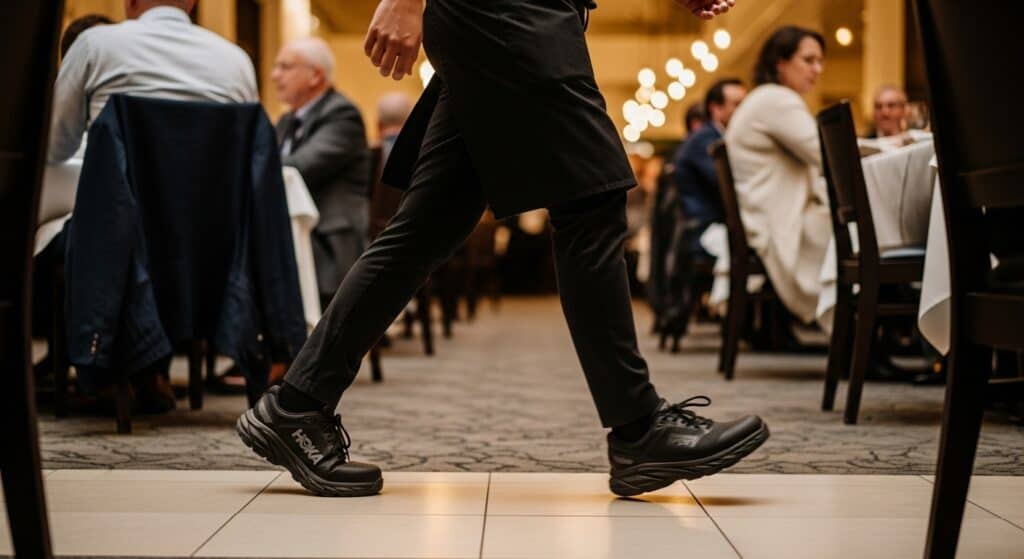
best shoes for your specific kitchen job
Final Advice on Materials and Care
- Avoid Mesh Uppers in BOH: Mesh is comfortable and breathable, but hot liquid spills (oil, water, stock) will pass through instantly and cause a severe burn. Non-porous materials like Polyurethane (PU) or solid EVA clogs allow hot spills to run off, giving you time to kick the shoe off.
- Lace-Ups vs. Slip-Ons: Clogs (slip-ons) are a critical safety feature for kitchens because if hot liquid spills inside, you can kick them off instantly. Lace-up boots, while offering ankle support, can trap hot liquids.
- Clean the Tread: Grease, flour, and debris that get packed into the outsole tread will quickly compromise your slip resistance. Clean the outsoles regularly with a brush and mild soap to maintain their effectiveness.
- Dry Them Properly: Never dry shoes on top of a hot oven or radiator, as excessive heat can warp materials, degrade glue, and reduce their slip resistance. Always air-dry completely.
Frequently Asked Questions (FAQ)
Are regular Crocs or sneakers “non-slip”?
Absolutely NOT. Regular Crocs (with the holes) and standard sneakers are a safety hazard. Their soles are not oil-resistant and are dangerously slippery on a greasy floor. You must buy a shoe from a “Work” line (like Crocs at Work or Skechers for Work) that is certified slip-resistant (SRC rated).
How long should my kitchen shoes last?
Honestly? Be prepared to replace them often. A kitchen is one of the most brutal environments on footwear. A lightweight cemented shoe (like a Skechers) will likely last 6-12 months. A durable PU clog (like the Birki) can last 2+ years.
My feet hurt. Do I need more cushion or more support?
You need support. Soft, squishy insoles (like basic memory foam) feel good for an hour but let your arch collapse, causing plantar fasciitis. A shoe with a supportive footbed (like the Birkenstock or Dansko) is what you need to prevent pain over a 12-hour shift.
Do I need a safety toe in a kitchen?For most servers or line cooks, no. But if you are a barback (moving heavy kegs), a receiver (moving heavy boxes), or a dishwasher (risk of dropping heavy pots), a steel or composite toe (like in the Blundstone 990 or KEEN Kourse) is a very smart idea.
Conclusion: The Final Verdict for Your Kitchen
Your shoes are the most important tool you own. Stop buying cheap, non-certified shoes. Look for an SRC-rated slip-resistant sole and a supportive footbed that can handle 12 hours on tile. Your feet, knees, and back will thank you.
The Guru’s TL;DR Choice:
| Your Role | Our Top Pick |
|---|---|
| BOH / Chef / Line Cook | Birkenstock Profi Birki (Durability) or Dansko XP 2.0 (Support) |
| FOH / Server / Bartender | Skechers Work Flex (Value) or Hoka Bondi SR (Max Cushion) |
| Dishwasher / Deep Clean | Muck Boot Chore (100% Dry) or Crocs Bistro (Budget) |
| Manager / Barback | Blundstone 990 (Protection + Style) |
| On a Tight Budget | New Balance 626v2 or Crocs Bistro |
Invest in your safety and comfort—you’ve earned it.

